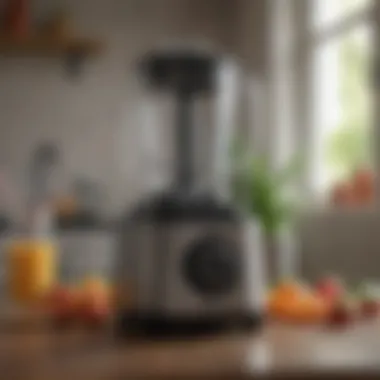Selecting the Best Small Blender for Your Smoothies


Intro
Selecting the right small blender specifically for making smoothies can feel like finding a needle in a haystack. With countless models cluttering store shelves and online marketplaces, how does one sift through the confusion and land the ideal machine? This article takes a thorough look at the key, and often overlooked, factors that should weigh into your decision-making process. From design nuances that blend seamlessly with your kitchen aesthetics to the horsepower and blade quality that impact performance, we'll break it all down.
Smoothies are not just a trendy beverage; they are a lifestyle choice! A daily blend of fruits, vegetables, and sometimes protein can elevate one's nutrition without a significant time investment. The right small blender can make this healthy habit enjoyable and efficient.
In the coming sections, we will review top picks available on the market today, analyze their features, and showcase why a small blender is particularly advantageous for smoothie enthusiasts. The aim is to empower you with knowledge, ensuring you make a decision that resonates with your unique taste and requirements.
Understanding Your Blender Needs
When it comes to picking a small blender for your smoothie adventures, understanding your blender needs is like laying the groundwork for a solid foundation. It informs your choices and helps you navigate the expansive world of blending gadgets. With a plethora of options out there, knowing precisely what you're after can save you a whole lot of time and potentially some cash. Choosing the right blender can enhance your smoothie game, making it easier to whip up nutritious concoctions that align with your taste.
Assessing Your Smoothie Preferences
Your smoothie preferences form the crux of what features you’ll prioritize in a small blender. Maybe you're a fruit fanatic, delighting in vibrant tropical mixes with bananas, mangoes, and a splash of coconut water. Alternatively, perhaps you lean towards a green smoothie packed with spinach, kale, and a handful of nuts. Each choice caters to different textures and mixing requirements, ultimately affecting which features you should focus on.
- Texture Matters: If you favor creamy smoothies, a blender featuring strong blades and a robust motor is a must. A blender that can crush ice and blend fibrous fruits will yield the smooth consistency you're after.
- Ingredient Variety: Consider what you typically throw into your blender. If frozen fruits are your go-to, ensure that the motor power can handle that heavier load without burning out. For those who enjoy adding flaxseeds or chia seeds, a finely crafted blade could be essential to achieve the desired blend.
Additionally, think about your blending habits—do you prefer a quick mix or are you ok with that prolonged pulsing to achieve the perfect texture? This self-assessment can lead you to the perfect small blender tailored for your smoothie-making rituals.
Identifying Common Use Cases
Understanding how you plan to use your blender plays a significant role in selecting the right one. Different scenarios require different features, so being clear about your intended usage will further narrow down your options.
- Daily Smoothies: If you’re planning on making smoothies daily, look for a model that is not only efficient but also sturdy enough to handle frequent use. A solid base and reliable motor would save you headaches down the line.
- Occasional Treats: For occasional blending of a smoothie or two, you might not need the fanciest model. A smaller blender that’s easy to store and doesn’t take up too much counter space could be sufficient.
- Meal Replacement: If you’re considering replacing meals with smoothies, you'll want a blender that allows for versatile creations, from heartier blends with protein powder to deliciously dessert-like options with added sweeteners or yogurt.
By identifying these common use cases, you can zero in on that perfect small blender that not only meets your needs but also makes the blending experience enjoyable.
Remember, the right blender doesn't just make smoothies; it enhances your lifestyle, making nutritious choices that much easier.
Key Features to Look For
When navigating the landscape of small blenders, recognizing what features are vital can be a real game changer. The right small blender does more than blend; it tailors to your lifestyle and smoothie-making rituals. Whether you're a busy professional or a leisurely smoothie aficionado, comprehending these key characteristics is paramount for making the right choice.
Motor Power and Performance
The motor power of a blender is often the heart of its performance. Typically ranging from 200 to 1000 watts, the wattage dictates how well a blender can pulverize ingredients. A stronger motor means an easier time blending tougher foods, like frozen fruits or leafy greens. Think about it: if you often throw in ice or hard vegetables, a high-wattage blender can turn those frozen chunks into a smooth concoction without batting an eye.
But not just wattage matters; the design and engineering of the motor also influence efficiency. Efficiency ties into how quickly and evenly the ingredients blend, which is crucial for achieving that dreamy, creamy texture. Smoothies are the star of your breakfast, so having the right motor power ensures you get the smoothness you crave.
Blender Size and Capacity
Size is another key component when investing in a small blender. A compact design is often desirable, especially for homeowners with limited counter space or those who appreciate an easy clean-up. When you think of size, consider capacity alongside – smaller containers often cater to single servings, perfect for those who blend just enough for one. Conversely, if you plan to share your smoothies with family members or hosts, a slightly larger model could save you time.
Don’t forget about the portability as well. A lightweight blender can join you on picnics or during travels, making it easier to stick to that healthy lifestyle wherever life takes you.
Blade Design and Material
The blades are the unsung heroes of your blender. The design of the blades can make all the difference between a lumpy smoothie and a silky-smooth one. Look for stainless steel blades which typically offer superior durability and resistance to corrosion.


Another effective design includes angled blades, which create an efficient vortex that pulls ingredients toward the blades, promoting even blending. If you notice any flimsy or plastic blades, it might be worth reconsidering. Stronger blades are essential for chopping ice, nuts, and fibrous vegetables, bringing out the best flavors in your smoothies.
Ease of Cleaning and Maintenance
The hustle and bustle of daily life can make anyone dread a complicated clean-up process. Thus, ease of cleaning should never be an afterthought. Blenders with removable blades or dishwasher-safe components can save a lot of time and headaches after blending your green goddess smoothie. Consider a model with a self-cleaning feature as well – all you have to do is add water and a drop of soap.
Moreover, some blenders come with components made from materials resistant to stains and odors. This ensures that the blend of your next smoothie won’t unintentionally taint the flavor of previous mixes. If you only have to rinse and not scrub, it’s a win-win!
"A good blender should not just blend; it should ease your life and inspire your culinary experiments."
In the end, focusing on these key features gives you a blueprint that aligns with your smoothie-making aspirations. Remember, a good small blender isn't just a gadget; it's a companion for healthy living.
Top Small Blenders for Smoothies
When it comes to making smoothies, the choice of blender is key. Small blenders are designed to churn out perfectly blended smoothies while taking up minimal counter space and offering convenience. They’re often more affordable, easier to clean, and usually lightweight enough to be easily stored or moved around. For many homeowners, interior design enthusiasts, party hosts, and gardening aficionados, investing in a small blender can streamline the process of whipping up healthy drinks that fit into a busy lifestyle.
High-quality smoothies require not just the right ingredients but also the right equipment. Selecting a compatible blender tailored for smoothie preparation ensures durability and performance efficiency. In this section, we will delve into some of the best brands that create remarkable small blenders tailored specifically for smoothies. Below, we will detail a few prime options you might consider.
Brand A Overview and Features
Brand A has established itself as a staple in the blender market. Known for its robust performance, this brand offers several small blender models that cater specifically to smoothie lovers. One of its standout features is the powerful motor, which can tackle leafy greens and frozen fruits with ease.
The design is sleek and appealing, making it a suitable addition to any kitchen.
- Motor Power: Generally ranges between 300 to 600 watts, allowing for a smooth blend without overheating.
- Size: Compact enough to fit in most kitchen cabinets while still accommodating a reasonable capacity, usually around 20 oz to 32 oz.
- Blade Design: Stainless steel blades that are sharp enough to crush ice but also gentle enough for soft fruits.
This brand is particularly loved for its user-friendly interface, often featuring simple one-touch buttons. Great for users who prefer a no-fuss option while still desiring quality in their blend.
Brand B Overview and Features
Brand B is another noted contender in the small blender lineup, often praised for its innovative technologies. One unique selling point is its smart blending features; - it automatically adjusts the blending time and speed based on the ingredients you load.
The aesthetic also deserves mention, as it comes in several color options to match various kitchen decors.
- Motor Power: Most models operate around 500 watts which helps in achieving both creamy and icy smooth textures.
- Capacity: Typically smaller, making it ideal for personal servings, with containers that range from 12 oz to 24 oz.
- Ease of Use: One of the biggest draws is its easy-to-assemble design that promotes quick clean-up after use.
Customer reviews often highlight the effectiveness of its blending technology, ensuring consistent results every time.
Brand Overview and Features
Brand C has a solid reputation for durability and reliability, which makes it preferable among more health-conscious consumers. Its smaller blender models are designed with performance in mind, producing smooth results even with fibrous vegetables.
- Motor Power: Generally falls in the range of 400 to 900 watts, providing versatility for various ingredients.
- Blade Material: High-quality, titanium-coated blades that resist dulling, making it a long-lasting kitchen device.
- Capacity: Offers a slightly larger capacity when compared to others, around 32 oz, for those who appreciate larger batches.
Brand C blends quality and functionality at a reasonable price point, thus gaining a loyal customer base.
Brand Overview and Features
Brand D is well-known for its emphasis on eco-friendliness and health. Their small blenders often incorporate BPA-free materials, catering to environmentally conscious buyers. Furthermore, these blenders boast a quieter motor, aiming to reduce noise pollution in the kitchen.
- Motor Power: Around 300 watts, which works efficiently for smoothies that don't require heavy ice crushing.
- Design: Lightweight and compact with various color choices for aesthetic appeal.
- Smart Features: Some models include a timer feature to prevent overheating and overblending.


Ultimately, if you prioritize eco-conscious choices alongside functionality, Brand D may resonate with your values and blending needs.
"Selecting the right blender can transform your smoothie experience from a chore to a delightful ritual."
Each of these brands offers unique qualities that can enhance your smoothie adventures. By understanding the specific features and advantages of these top small blenders, you’ll be better equipped to make a decision that aligns with your lifestyle and preferences.
Comparing Performance and Efficiency
When venturing into the world of small blenders, it becomes clear that performance and efficiency are not merely buzzwords; they serve as the backbone of a blender's value. For smoothie aficionados, a high-performance machine means not just blending ingredients but seamlessly integrating flavors and textures, ensuring a consistent and delightful experience with every sip. Performance can often define the difference between a smoothie that tastes great and one that ends up as a lumpy disaster.
Moreover, an efficient blender saves time and energy, making it an invaluable addition to busy kitchens where quick meal prep is vital. Understanding the speed, blending power, and ability to maintain quality under pressure helps in distinguishing the wheat from the chaff among various models. Keeping this in mind, we dive deeper into two critical aspects: blending speed analysis and texture quality.
Blending Speed Analysis
Speed plays a significant role in how effective a blender is in producing smoothies that meet your expectations. A rapid blending speed equates to a quicker whipping of fruits and veggies, breaking down fibrous materials. This powerful whir may also mean less work for the motor, which often contributes to longevity of the appliance.
While many blenders boast high speeds, it’s essential to realize that speed alone doesn’t guarantee a smoothie of desirable quality.
- Higher RPMs (revolutions per minute) can pulverize harder ingredients like nuts and ice better.
- Speed settings—some blenders come with presets for smoothies, which can be handy.
- For those who prefer a blend that incorporates whole fruits, it’s crucial to find a model that handles the transition from solid to liquid efficiently. Too many blenders falter at this stage, leaving you with an undesirable mixture of large chunks and puree.
When checking out blending speeds, look beyond just the motor specs. Take note of how these speeds align with the types of recipes you wish to create.
Texture Quality of Smoothies
Once you have taken speed into account, the next hurdle revolves around texture. No one wants a smoothie that feels grainy or has unblended bits swirling around. Ideally, a blender should leave behind a silky, smooth consistency, providing an enjoyable drinking experience.
Texture quality can depend on various factors:
- Blade Design: A blade's shape and material can significantly affect blending efficiency. Stainless steel blades often do a better job at cutting through tough ingredients than their plastic or coated counterparts.
- Container Shape: The shape of the container also influences how ingredients circulate. A well-designed container encourages vortex action, pulling ingredients towards the blades with remarkable efficiency.
- Pulsing Functionality: Some blenders come equipped with pulsing options, allowing for a fine-tuning of texture, especially handy for those who enjoy chunkier, fruit-filled smoothies.
Ultimately, the synergy between speed and texture determines the quality of your smoothies. Spending a little extra time analyzing these elements can pay off in a blender that consistently delivers smooth, delicious results.
"Performance and efficiency of a blender can transform an ordinary smoothie into an extraordinary experience."
In summary, when considering a small blender for smoothies, comparing performance and efficiency allows homeowners, party hosts, or anyone passionate about healthy living to make a choice that suits their unique culinary endeavors.
User Experience and Customer Feedback
When it comes to purchasing a small blender for smoothies, user experience and customer feedback are invaluable components that play a pivotal role in guiding your decision. These insights provide a fleshed-out understanding of how the product performs in real-life scenarios, beyond the glossy marketing claims. A machine might look like a powerhouse on paper, with impressive specs and features, but the actual experience of users can tell you whether it’s an easy-to-use gadget or a complicated contraption that collects dust on the shelf.
Positive user experiences can point out why a specific blender stands out from the crowd. They often reveal aspects that manufacturers might not highlight, such as how easy it is to clean, whether it can handle frozen fruits without trouble, or if it operates louder than a jet engine. Moreover, customer feedback can help you judge if it lives up to claims regarding smoothie texture, speed, and durability.
Evaluating Online Reviews
Online reviews are a treasure trove when seeking to evaluate a small blender. Platforms like Amazon, Reddit, and various kitchen appliance review sites host a wealth of user opinions, experiences, and ratings. The beauty of these reviews lies in the sheer volume; you can sift through several perspectives to gauge patterns in feedback.
Look for:
- Star ratings: A one to five-star rating often gives a quick gauge of overall user satisfaction.
- Detailed comments: Users frequently explain their ratings, describing what worked and what didn't, painting a clearer picture of the product's capabilities.
- Photos and videos: Many reviewers upload their own content showing real-world usage, which can provide insight into size, performance, and results.
While sifting through reviews, pay attention to both extremes—those who love the product and those who dislike it. This balanced assessment can help you avoid any potential pitfalls.


Common Complaints and Praises
Every product has its pros and cons, and small blenders are no exception. Customers usually highlight certain features that either delight or frustrate them.
Common Complaints
- Noise Level: Some models can be loud, disturbing your morning peace while blending.
- Durability: A few users report that the blender broke down after limited use, raising questions about the materials used.
- Poor Ice Crushing: Users sometimes discover their blender struggles with frozen fruits or ice, resulting in less-than-ideal smoothie textures.
Common Praises
- Ease of Use: Many enthusiasts laud the straightforward design and efficient blending process of their favorites, allowing for a quick morning routine.
- Compact Size: Users often appreciate a blender that fits neatly on countertops or in cabinets without taking much space.
- Versatility: Some models receive high marks for functioning well, not just for smoothies but also for sauces, soups, or even nut butters, making them a worthy addition to any kitchen.
User experience and customer feedback capture the essence of a product’s real-world performance. By tapping into the wisdom of those who have already dealt with these blenders, you arm yourself with the knowledge necessary to make a more informed choice.
Pricing and Value Considerations
Choosing a small blender for smoothies isn't just about picking something that looks good on your countertop; it's about understanding how the price aligns with the functionality and longevity of the product. This section dives deep into why pricing and value should be at the forefront of your decision-making process. While a bargain might be tempting, it’s crucial to weigh the cost against the benefits you’ll gain. After all, your blender should serve your smoothie-making needs reliably and efficiently.
Budget Options vs High-End Models
When considering small blenders, you typically face two broad categories: budget-friendly options and high-end models.
- Budget Options: These blenders often come with basic features, adequate power, and smaller capacities. They can be perfect if you're just starting your smoothie journey or plan to use the blender occasionally. For instance, a blender priced around fifty dollars can handle fruits and liquids, but it might struggle with tougher ingredients like ice or fibrous veggies.
- High-End Models: In contrast, models costing over a hundred dollars often boast superior motor power, diverse speed settings, and high-quality materials. These blenders tend to create smoother blends, handle a wider variety of ingredients, and come with longer warranties. Consider investing in brands well-regarded in the industry, as they may not only serve your immediate needs but also prove to be worth the splurge in the long run.
One must keep in mind the phrase "you get what you pay for"—this holds true in the blender world. Spending a bit more can mean a significant improvement in performance and durability.
Long-Term Cost Efficiency
Looking ahead, long-term cost efficiency emerges as a key concern. The initial price tag of your blender might not tell the whole story in terms of value. Here are a few points to mull over when reflecting on long-term costs:
- Durability: A cheaper blender may need replacement sooner than a higher-end version. If you find yourself buying a new unit every couple of years, that initial savings evaporates quickly.
- Energy Usage: Not all blenders are created equal when it comes to power consumption. More efficient models blend faster and at lower power, which can translate to savings on your electric bill over time.
- Maintenance and Repairs: Understanding warranty coverage is crucial. Many high-end blenders offer long warranties that cover repairs or replacements, which can save you money. Some budget blenders might have cheaper components that break easily, leaving you scrambling to replace them just as your smoothies start getting delicious.
In summary, while it can be tempting to veer towards low-cost options, the long view often reveals that investing in a reliable, high-quality blender can save you money, effort, and frustration in the long haul. Remember, smooth and hassle-free blending is worth its weight in gold.
Epilogue and Recommendation
Selecting the right small blender for smoothies goes beyond mere brand recognition or flashy features. It's about understanding how it aligns with your lifestyle and preferences. In today’s world, where health-conscious choices are becoming increasingly paramount, having an optimal blender can significantly facilitate your journey towards a healthier diet.
The specific elements that should be taken into account include motor power, ease of cleaning, and size, to match your typical portion sizes and blending habits. This decision is not just about acquiring a kitchen appliance; it’s an investment in your wellbeing. Choosing the right device can mean the difference between having a smooth, delightful morning shake or a lumpy concoction that leaves you reaching for the coffee instead.
Additionally, considering aspects like warranty, return policy, and customer service can make a notable difference in your satisfaction down the road. An informed choice today can save you from buyer's remorse tomorrow.
Final Thoughts on Selection Criteria
When evaluating a small blender, it’s crucial to keep your specific needs top-of-mind. Here’s what to focus on:
- Personal Usage: Whether you plan to whip up a quick smoothie for breakfast or prepare frozen fruit desserts for your kids, your usage will significantly determine the type of blender you need.
- Space Considerations: Small kitchens or minimal counter space can make or break your choice. Compact models or those that can easily fit under cabinets often come in handy.
- Features vs. Needs: Some blenders boast features like multiple speed settings and pre-programmed cycles while you might not require all those bells and whistles. Assess which features will genuinely benefit your smoothie-making process.
By tethering your selection criteria to your actual needs, you not only simplify the decision-making process but also ensure that the blender you choose will be a joy to use, rather than a source of frustration.
Recommended Blender Models
Based on thorough research and the insights gathered, here are a few standout models that consistently receive praise among users for their performance, reliability, and overall value:
- Ninja Personal Blender: Known for its powerful motor and sleek design, this blender handles everything from leafy greens to frozen fruits with ease. Reviewers often commend it for creating smooth, consistent textures without much effort.
- NutriBullet Pro: A favorite in many households, the NutriBullet Pro is compact and delivers impressive performance. Designed specifically for smoothies, the blades are sharp, and the blending cups are ideal for on-the-go lifestyles.
- Hamilton Beach Personal Blender: This budget-friendly option doesn’t compromise on performance. Users appreciate the ease of use and straightforward cleaning process, making it a suitable choice for those easing into healthier eating habits.
- Oster My Blend: With its sporty design, this model is perfect for the active individual who loves smoothies post-workout. Its blending jar doubles as a travel bottle, adding convenience for those always on the move.
By considering these models and aligning your choice with personal needs highlighted in this article, you're poised to enhance your smoothie-making experience effectively. Overall, making a thoughtful choice will pave the way for a smoother and healthier journey ahead.



